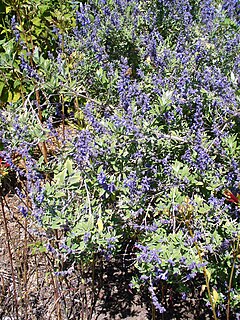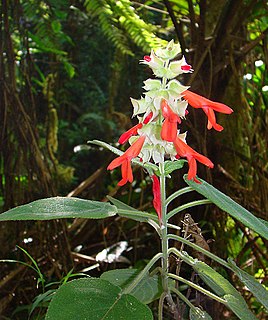
Salvia officinalis, the common sage or just sage, is a perennial, evergreen subshrub, with woody stems, grayish leaves, and blue to purplish flowers. It is a member of the mint family Lamiaceae and native to the Mediterranean region, though it has been naturalized in many places throughout the world. It has a long history of medicinal and culinary use, and in modern times it has been used as an ornamental garden plant. The common name "sage" is also used for closely related species and cultivars.

The black-backed thornbill is a species of hummingbird in the family Trochilidae. It is found in the Sierra Nevada de Santa Marta. The species is currently endangered due to threats such as logging and forest fires.
Salvia curticalyx is a species of flowering plant in the family Lamiaceae that is native to Ecuador. Its natural habitat is subtropical or tropical moist montane forests.
Salvia ecuadorensis is a species of flowering plant in the family Lamiaceae that is native to Ecuador. Its natural habitat is subtropical or tropical moist montane forests.

Salvia flocculosa is a species of flowering plant in the family Lamiaceae that is native to Ecuador. Its natural habitat is subtropical or tropical moist montane forests.
Salvia humboldtiana is a species of flowering plant in the family Lamiaceae that is endemic to Ecuador. Its natural habitat is subtropical or tropical dry valley shrubland.

Salvia leucocephala is a species of flowering plant in the family Lamiaceae that is native to Ecuador. Its natural habitat is subtropical or tropical dry shrubland.
Salvia lobbii is a species of flowering plant in the family Lamiaceae that is native to Ecuador. The plant is named after William Lobb (1809–1864), the English plant collector.
Salvia loxensis is a species of flowering plant in the family Lamiaceae that is native to Ecuador. Its natural habitats are subtropical or tropical moist montane forests and subtropical or tropical high-altitude shrubland.
Salvia peregrina is a species of flowering plant in the family Lamiaceae that is native to Ecuador. Its natural habitat is subtropical or tropical moist mountains.
Salvia quitensis is a species of flowering plant in the family Lamiaceae that is native to Ecuador. Its natural habitats are subtropical or tropical moist montane forests and subtropical or tropical high-altitude shrubland.
Salvia sprucei is a herbaceous perennial in the family Lamiaceae that is native to Ecuador, growing at 7,000 feet (2,100 m) elevation or higher in thick scrub on steep slopes. It was named in 1898 by botanist John Isaac Briquet for the British plant collector Richard Spruce. It is likely that Spruce discovered the plant on a collecting trip in Ecuador in 1857.
Salvia trachyphylla is a species of flowering plant in the family Lamiaceae that is native to Ecuador. Its natural habitats are subtropical or tropical moist montane forests and subtropical or tropical high-altitude shrubland.
Salvia unguella is a species of flowering plant in the family Lamiaceae that is native to Ecuador. Its natural habitat is subtropical or tropical moist montane forests.
Salvia veneris, the Kythrean sage, is a species of flowering plant in the family Lamiaceae that is endemic to Cyprus. It is found in a very small area just west of the village of Kythrea. A study in 2004 found only approximately 4,000 surviving plants.

Salvia candelabrum is a species of flowering plant in the family Lamiaceae, native to Spain. It is a woody-based perennial growing to 100 cm (39 in), with woolly grey-green leaves that resemble those of the common sage, S. officinalis, and emit a similar scent when crushed. In summer it bears violet-blue flowers on branching stems held high above the foliage.

Salvia caymanensis, the Cayman sage, is a short-lived perennial plant in the genus Salvia that is endemic to Grand Cayman in the Cayman Islands. It was thought to be extinct for nearly 40 years until it was rediscovered in 2007. After the damage caused by Hurricane Ivan in 2004, conservationists thought that conditions might be ideal for the reappearance of Salvia caymanensis if there was still viable seeds in the wild. A wanted poster, offering a 1000 CI$ reward, led to the discovery of the first plants seen since 1967.

Salvia is the largest genus of plants in the sage family Lamiaceae, with nearly 1000 species of shrubs, herbaceous perennials, and annuals. Within the Lamiaceae, Salvia is part of the tribe Mentheae within the subfamily Nepetoideae. One of several genera commonly referred to as sage, it includes two widely used herbs, Salvia officinalis and Salvia rosmarinus.
Salvia taraxacifolia is a species of flowering plant in the Lamiaceae family. It is referred to by the common name Dandelion leaved sage and is a herbaceous perennial shrub that is endemic to southwest Morocco, growing in the Atlas Mountains at elevations ranging from 2,000 feet (610 m) to 8,000 feet (2,400 m). Very adaptable, it grows on limestone slopes, forest clearings, and rocky riversides. It has no close allies in the genus Salvia. The specific epithet, taraxacifolia, is likely Persian in origin and means 'leaves shaped like a dandelion'.
Salvia herbanica is a critically endangered perennial plant that is endemic to the Canary Islands, growing in the mountains of southern-central Fuerteventura, at 250 to 400 m elevation. In 2004 there were only 212 known plants in the wild, in ten locations, with fewer than 50 plants in each location. Habitat for the plant continues to shrink due to predation by herbivores. Less than 50 of the plants are safe from predation, with the rest of the plants in poor health.






